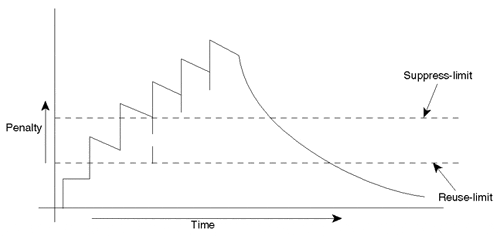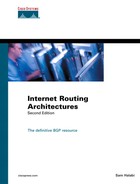BGP Stability Features
Of course, developing effective routing policies and configuring them correctly is at the core of building stability. BGP's attribute selections, as discussed throughout this book, are tools for building that core stability. In addition, here are some BGP functions that can help provide a buffer against route instability effects:
-
Controlling route and cache invalidation
-
BGP route refresh
-
BGP route dampening
Controlling Route and Cache Invalidation
The basis of any BGP conversation is the transport protocol connection that takes place between two neighbors. The neighbor connection itself is based on the OPEN message, which contains parameters such as the BGP version number. In addition, exchanged routing updates carry different attributes such as the metric, communities, and AS_PATH. Whenever an administrator changes attributes or policies, traditional BGP implementations require that a BGP TCP session with its neighbor be reset (broken and restarted) before the modified routing behavior will take effect.
Unfortunately, every time the TCP session is reset, routing is interrupted. When a session is reset, the routing cache is invalidated, routes disappear, and route instability cascades throughout the Internet. By the time the session is back online and routes and caches are reestablished, real damage could result.
Cisco Systems introduced a mechanism called soft reconfiguration that enables administrators to reconfigure attributes on the fly without killing an already established TCP session or manually introducing a route flap. Therefore, the routing cache is not cleared, and the impact on the route is minimal.
Tip
See the section Controlling Route and Cache Invalidation in Chapter 12.
The offshoot of using soft reconfiguration is that it requires a set of unmodified routes (the respective Adj-RIB-In, which should be inline with the peer's Adj-RIB-Out) from the specified peer(s) to be stored in local memory. The memory consumption required for utilizing soft reconfiguration with large peers can be quite significant. A rule of thumb is that for each route learned from the peer, assume that 250 bytes of memory is required to store it.
BGP Route Refresh
Another solution was introduced recently that removes the memory consumption offshoot associated with using soft reconfiguration. This alternative approach, referred to as route refresh capability, utilizes BGP-4 Capabilities Negotiation (discussed in Chapter 5, "Border Gateway Protocol Version 4") to facilitate a means of dynamically requesting that a peer readvertise all the prefixes learned from the peer (its Adj-RIB-Out).
This behavior is enabled by default in newer versions of IOS and must be supported by the BGP peer router in order to use the feature. BGP route refresh removes the overhead of memory and CPU consumption required when using soft reconfiguration. It also allows all the prefixes learned from the peer to be examined and subjected to the new policy without requiring the BGP session to be reset.
Tip
See the section BGP Route Refresh in Chapter 12.
Route Dampening
Another mechanism for controlling route instability is route dampening. A route that appears and disappears intermittently causes BGP UPDATE and WITHDRAWN messages to be repeatedly propagated on the Internet. The tremendous amount of routing traffic generated can use up all the link's bandwidth and drive up CPU utilization of routers.
Tip
See the section Route Dampening in Chapter 12.
Dampening categorizes routes as well either behaved or ill behaved. A well-behaved route shows a high degree of stability during an extended period of time. On the other hand, an ill-behaved route experiences a high level of instability in a short period of time. Ill-behaved routes should be penalized in a way that is proportional to the route's expected future instability. An unstable route should be suppressed (not advertised) until there is some degree of confidence that the route has become stable.
A route's recent history is used as a basis for estimating future stability. To track a route history, it is essential to track the number of times the route has flapped over a period of time. Under route dampening, each time a route flaps, it is given a penalty. Whenever the penalty reaches a predefined threshold, the route is suppressed. The route can continue to accrue penalties even after it is suppressed. The more frequently a route oscillates in a short amount of time, the faster the route is suppressed.
Similar criteria are put in place to unsuppress a route and start readvertising it. An algorithm is implemented to decay (reduce) the penalty value exponentially. The algorithm bases its configuration on a user-defined set of parameters. The following set of terms and parameters applies to the Cisco implementation:
-
Penalty— An incremented numeric value that is assigned to a route each time it flaps.
-
Half-life— A configurable numeric value that describes the amount of time that must elapse to reduce the penalty by one-half.
-
Suppress limit— A numeric value that is compared with the penalty. If the penalty is greater than the suppress limit, the route is suppressed.
-
Reuse limit— A configurable numeric value that is compared with the penalty. If the penalty is less than the reuse limit, a suppressed route that is up will no longer be suppressed.
-
Suppressed route— A route that is not advertised, even if it is up. A route is suppressed if the penalty value is greater than the suppressed limit.
-
History entry— An entry used to store flap information. For the purposes of monitoring and calculating a route's oscillation level, it is important to store this information in the router when the route oscillates. When the route stabilizes, the history entry becomes useless and must be flushed from the router.
Figure 10-1 illustrates the process of assessing a penalty to a route every time it flaps. The penalty is exponentially decayed according to parameters such as the half-life. The half-life parameter can be changed by the administrator to reflect the oscillation history of a route: A longer half-life might be desirable for a route that has a habit of oscillating frequently. A larger half-life value would cause the penalty to decay more slowly, which translates into a route's being suppressed longer.
Figure 10-1. Route Dampening Penalty Assessment

Stability Inside the AS
The benefits of route dampening are noticed inside as well as outside an autonomous system. When BGP is redistributed (injected) into an IGP, it is important that BGP instability does not affect internal routing in such a way as to cause a meltdown inside the AS. This is where route dampening can be useful. Routes that are flapping will be suppressed and prevented from being injected into the AS until they show some degree of stability. Figure 10-2 compares the effects of EBGP flapping on an IGP with and without route dampening.
Figure 10-2. Effects of EBGP Flapping on an IGP

In Figure 10-2, routes R1, R2, and R3 are injected from BGP into the AS. The up and down arrows next to R2 indicate that it is flapping. The routes are carried via IBGP and/or IGP depending on how the administrator is injecting the routes into the AS. In either case, the oscillations of R2 create major overhead for the border router and on the interior routers. IGPs will flood and remove the route as long as the route is unstable. With route dampening, the ill-behaved route will be suppressed (after reaching the suppress limit) and will be prevented from entering the AS.
Instabilities Outside the AS
Route dampening can prevent unstable EBGP routes from being propagated to other peers. This can save on link bandwidth usage and processing overhead within border routers. If you are a provider with multiple customers using your services, it is important not to burden your own network (and the outside world) with instabilities that go on inside a customer's network. In the case where a provider advertises a customer's network as part of an aggregate, this is not an issue. The aggregate will be stable (always advertised) even if most of its elements are not. Nonetheless, within the provider's AS, a customer's instabilities are a concern. When a customer's network cannot be aggregated (due to multi-homing or addresses not being part of the provider's address space), instabilities will be carried to the outside world.
With dampening, the provider's border router suppresses customer routes that are flapping. Suppression will take effect according to the dampening rules and parameters discussed earlier in this section. Figure 10-3 illustrates route dampening in an ISP environment.
Figure 10-3. Route Dampening: ISP Environment

One possible side effect of route dampening is that the customer will experience some short outages even if his routes become stable. In Figure 10-3, route R2 in the customer network is flapping. When the customer's ISP is running route dampening, R2 will be penalized and suppressed according to its level of oscillation. R2 could be dampened for minutes. Even if R2 stops oscillating, the penalty it had accumulated still might be far above the reuse limit, and it has to be decayed before the route can be used. In the meantime, some poor soul on the customer's network is pulling out his or her hair trying to figure out why some subnets can't be reached from the outside world. If administrators are unaware that their routes are being dampened, they might try to remedy the situation by some other means, which makes their routes flap even more and become more penalized. The better approach is to ask the provider whether he is receiving the routes, and if he is, check why they are not being advertised. Providers have strict policies and might not change the dampening behavior per the customer's request. What the provider can do is "flush" the history information of the routes being dampened to advertise the route. This is, of course, under the condition that the customer will investigate the routing problems causing the routes to fluctuate.
On the other hand, instabilities can be caused by the providers themselves, and the effect can be much larger. If a link carrying full routes between a provider and customer or a provider and another provider oscillates, the border routers will feel the impact.
Suppose that you are getting full Internet routes (currently about 75,000 routes) from multiple providers. Now imagine that 5 percent of these routes (about 3,750 routes) are toggling every 2 minutes. Your border router will be unable to handle this load.
Without route dampening, it is difficult to determine what is really happening. All you know is that the process utilization on your border router is increasing rapidly. With route dampening, all the unstable routes generate a history entry that shows the routes' level of stability. After the unstable routes are identified, it is easy to determine where they are coming from by looking at the next-hop address. Although route dampening in this case did not help solve the problem, it helped identify who was causing the problem. After you identify the culprit, you can temporarily remove your BGP session with the ISP at fault. Pick up the telephone, call the ISP, and start complaining.
In conclusion, route instabilities in the Internet will affect everybody one way or the other. It is everyone's responsibility to minimize route oscillation by being more aware of the things they do and why they do them. Providers are becoming tougher on culprits; some providers apply harsher penalties to routes with longer masks, for example. This might sound like overkill, but it is getting harder to control the Internet. Having a "routing patrol" issue tickets whenever someone breaks the rules might become necessary.
